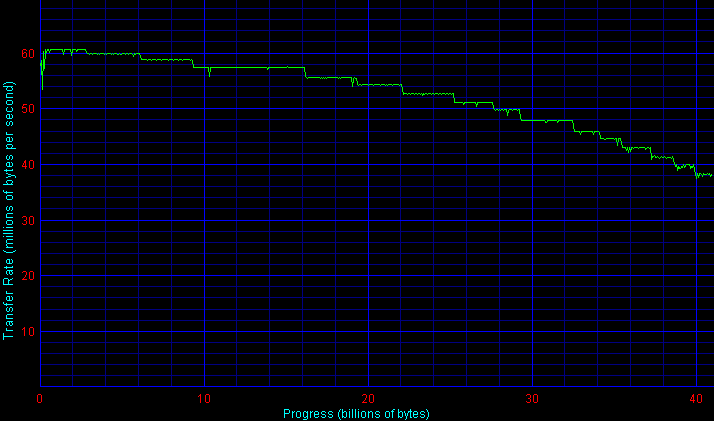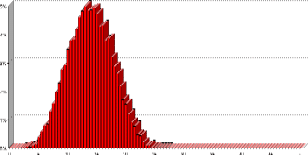|


Let’s see how the DM+8 stacks up.
Low-Level ResultsFor diagnostic purposes only, StorageReview measures the following low-level parameters: Average Read Access Time– An average of 25,000 random accesses of a single sector each conducted through IPEAK SPT’s AnalyzeDisk suite. The high sample size permits a much more accurate reading than most typical benchmarks deliver and provides an excellent figure with which one may contrast the claimed access time (claimed seek time + the drive spindle speed’s average rotational latency) provided by manufacturers. WB99 Disk/Read Transfer Rate – Begin– The sequential transfer rate attained by the outermost zones in the hard disk. The figure typically represents the highest sustained transfer rate a drive delivers. WB99 Disk/Read Transfer Rate – End– The sequential transfer rate attained by the innermost zones in the hard disk. The figure typically represents the lowest sustained transfer rate a drive delivers. |
For more information, please click here.
|
Note: Scores on top are better. |
|
|||||||||||||||||||||||||
|
|
||||||||||||||||||||||||
The DiamondMax Plus 8’s access time measures out at 14 milliseconds even. Subtracting 4.2 ms to account for the rotational latency of a 7200 RPM drive yields a measured seek time of 9.8 milliseconds and beats the advertised 10 ms spec.
Average write access times weigh in at a lethargic 18.2 milliseconds. While controller limitations prevent us from drawing scores from other contemporary drives, the DM+8’s score ranks among the slowest we have measured.
|
Note: Scores on top are better. |
|
|||||||||||||||||||||||
|
|||||||||||||||||||||||
6E040L0 Transfer Rate
|
|||||||||||||||||||||||
Equipped with an 80 GB platter, the DM+8 turns in an impressive 60.2 MB/sec transfer rate in its outermost zone. Its inner-zone mark of 40.0 MB/sec also sets a record for an ATA drive.
We should take a moment to note that all the figures presented on this page serve only as diagnostic figures and do not reveal much about application-level performance. Popular tools such as SiSoft’s Sandra 2003 and ATTO Powertools, for example, rely almost exclusively on sequential transfer rates in delivering their scores. Though they are relatively easy to use, these benchmarks simply are not indicative of any kind of high-level performance. Far too many readers place emphasis and make decisions on the meaningless results delivered by such programs.
It is application-level performance that determines how swift a drive feels. With that said, how does the DiamondMax Plus 8 fare in such tests?
Single-User PerformanceStorageReview uses the following tests to assess non-server use: StorageReview.com Office DriveMark 2002– A capture of 30 minutes of actual computer productivity use that exactingly recreates a typical office-style multitasking environment. The applications include: Outlook XP, Word XP, Excel XP, PowerPoint XP, Calypso (a freeware e-mail client), SecureCRT v3.3 (a telnet/SSH client), CuteFTP Pro v1.0 (an FTP/SSH client), ICQ 2000b), Palm Hotsync 4.0, Gravity 2.3 (a Usenet/newsgroups client), PaintShop Pro v7.0, Media Player v8 for the occasional MP3, and Internet Explorer 6.0. StorageReview.com High-End DriveMark 2002– A capture of VeriTest’s Content Creation Winstone 2001 suite. Applications include Adobe Photoshop v5.5, Adobe Premiere v5.1, Macromedia Director v8.0, Macromedia Dreamweaver v3.0, Netscape Navigator v4.73, and Sonic Foundry Sound Forge v4.5. Unlike typical productivity applications, high-end audio- and video- editing programs are run in a more serial and less multitasked manner. The High-End DriveMark includes significantly more sequential transfers and write (as opposed to read) operations. |
StorageReview.com Bootup DriveMark 2002– A capture of the rather unusual Windows XP bootup process. Windows XP’s boot procedure involves significantly different access patterns and queue depths than those found in other disk accesses. This test recreates Windows XP’s bootup from the initial bootstrap load all the way to initialization and loading of the following memory-resident utilities: Dimension4 (a time synchronizer), Norton Antivirus 2002 AutoProtect, Palm Hotsync v4.0, and ICQ 2000b.
StorageReview.com Gaming DriveMark 2002– A weighted average of the disk accesses featured in five popular PC games: Lionhead’s Black & White v1.1, Valve’s Half-Life: Counterstrike v1.3, Blizzard’s Diablo 2: Lord of Destruction v1.09b, Maxis’s The Sims: House Party v1.0, and Epic’s Unreal Tournament v4.36. Games, of course, are not multitasked- all five titles were run in a serial fashion featuring approximately half an hour of play time per game.
For more information, please click here.
|
Note: Scores on top are better. |
|
|||||||||||||||||||||||||||||||||||||||||||||
|
|
||||||||||||||||||||||||||||||||||||||||||||
|
|
||||||||||||||||||||||||||||||||||||||||||||
With a StorageReview.com Office DriveMark of 231 I/Os per second, the DiamondMax Plus 8 simply falls behind the competition… by a considerable distance. Similar margins play out in the Bootup and Gaming DriveMarks, though the DM+8 makes up a little ground in the relatively STR-heavy High-End DriveMark.
It is important to reiterate that, for consistency’s sake, our tests standardize on the largest (what we refer to as the “flagship”) drive in a given family. Due to the SR DriveMark suite’s “real world” nature, larger drives enjoy an advantage over smaller units. This advantage is realized in every day use- the larger the drive, the less physical distance it must seek in serving requests. This plays out both in long seeks as well as the much more common short, localized access typical in single-user scenarios. To be fair, we should note that the margin between the DM+8 and other leading drives would diminish a bit if the capacities were more even. It is clear, however, that one should not let the DM+8’s relatively high transfer rate scores seduce him or her into believing that it is a viable contender in high-performance applications.
Multi-User PerformanceStorageReview uses the following tests to assess server performance: StorageReview.com File Server DriveMark 2002– A mix of synthetically-created reads and writes through IOMeter that attempts to model the heavily random access that a dedicated file server experiences. Individual tests are run under loads with 1 I/O, 4 I/Os, 16 I/Os, and 64 I/Os outstanding. The Server DriveMark is a convenient at-a-glance figure derived from the weighted average of results obtained from the four different loads. StorageReview.com Web Server DriveMark 2002– A mix of synthetically-created reads through IOMeter that attempts to model the heavily random access that a dedicated web server experiences. Individual tests are run under loads with 1 I/O, 4 I/Os, 16 I/Os, and 64 I/Os outstanding. The Server DriveMark is a convenient at-a-glance figure derived from the weighted average of results obtained from the four different loads. For more information click here. |
|
Note: Scores on top are better. |
|
|||||||||||||||||||||||||||||||||||||||||||||
|
|
||||||||||||||||||||||||||||||||||||||||||||
When it comes to file server performance, the DiamondMax Plus 8 simply cannot keep up with other contemporary 7200 RPM drives. The drive gains a bit of ground, however, in the web server pattern, a setup that consists exclusively of reads.
Legacy PerformanceeTesting Lab’s WinBench 99 Disk WinMark tests are benchmarks that attempt to measure desktop performance through a rather dated recording of high-level applications. Despite their age, the Disk WinMarks are somewhat of an industry standard. The following results serve only as a reference; SR does not factor them into final judgments and recommends that readers do the same. |
|
Note: Scores on top are better. |
|
|||||||||||||||||||||||||||||||||||||||||||||
|
|
||||||||||||||||||||||||||||||||||||||||||||
Heat and NoiseIdle Noise– The sound pressure emitted from a drive measured at a distance of 18 millimeters. The close-field measurement allows for increased resolution between drive sound pressures and eliminates interactions from outside environmental noise. Note that while the measurement is an A-weighted decibel score that weighs frequencies in proportion to human ear sensitivity, a low score does not necessarily predict whether or not a drive will exhibit a high-pitch whine that some may find intrusive. Conversely, a high score does not necessarily indicate that the drive exhibits an intrusive noise envelope. Net Drive Temperature– The highest temperature recorded from a 16-point sample of a drive’s top plate after it has been under heavy load for 80 minutes. The figures provided are net temperatures representing the difference between the measured drive temperature and ambient temperature. For more information, please click here. |
|
Note: Scores on top are better. |
|
||||||||||||||||||||||||||||||||||||||||||
|
|
|||||||||||||||||||||||||||||||||||||||||
The DiamondMax Plus 8’s objective idle noise measurement weighs in at 41.8 dB/A at 7 millimeters. Though we honestly expected an even quieter figure given the drive’s single-platter configuration, its score is nonetheless well under the threshold of audibility. Seeks are also whisper quiet.
It is in heat measurements that the drive’s single-disk configuration and thin construction come into play. At just 14.2 degrees Celsius above ambient temperature, the DM+8 is among the coolest drives we’ve measured.
ReliabilityThe StorageReview.com Reliability Survey aims to amalgamate individual reader experiences with various hard disks into a comprehensive warehouse of information from which meaningful results may be extracted. A multiple-layer filter sifts through collected data, silently omitting questionable results or results from questionable participants. A proprietary analysis engine then processes the qualified dataset. SR presents results to readers through a percentile ranking system. According to filtered and analyzed data collected from participating StorageReview.com readers, the |
Note that the percentages in bold above may change as more information continues to be collected and analyzed. For more information, to input your experience with these and/or other drives, and to view comprehensive results, please visit the SR Drive Reliability Survey.
ConclusionDue partly to its low capacity and partly due to its smaller buffer size, the DiamondMax Plus 8 does not keep up with the state of the art from the competition. Those who seek high performance in an ATA drive should look towards other performance oriented lines such as Maxtor’s own DiamondMax Plus 9. To be fair, Maxtor itself hasn’t positioned the DM+8 as a high-performance unit but rather as a low-cost, low-capacity solution to satisfy entry-level needs ostensibly without sacrificing reliability. Users who require such a drive might consider the DiamondMax Plus 8. |





 Amazon
Amazon